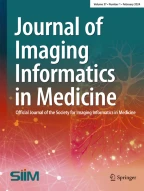Abstract
The motivation is to introduce new shape features and optimize the classifier to improve performance of differentiating obstructive lung diseases, based on high-resolution computerized tomography (HRCT) images. Two hundred sixty-five HRCT images from 82 subjects were selected. On each image, two experienced radiologists selected regions of interest (ROIs) representing area of severe centrilobular emphysema, mild centrilobular emphysema, bronchiolitis obliterans, or normal lung. Besides 13 textural features, additional 11 shape features were employed to evaluate the contribution of shape features. To optimize the system, various ROI size (16 × 16, 32 × 32, and 64 × 64 pixels) and other classifier parameters were tested. For automated classification, the Bayesian classifier and support vector machine (SVM) were implemented. To assess cross-validation of the system, a five-folding method was used. In the comparison of methods employing only the textural features, adding shape features yielded the significant improvement of overall sensitivity (7.3%, 6.1%, and 4.1% in the Bayesian and 9.1%, 7.5%, and 6.4% in the SVM, in the ROI size 16 × 16, 32 × 32, 64 × 64 pixels, respectively; t test, P < 0.01). After feature selection, most of cluster shape features were survived ,and the feature selected set shows better performance of the overall sensitivity (93.5 ± 1.0% in the SVM in the ROI size 64 × 64 pixels; t test, P < 0.01). Adding shape features to conventional texture features is much useful to improve classification performance of obstructive lung diseases in both Bayesian and SVM classifiers. In addition, the shape features contribute more to overall sensitivity in smaller ROI.
Similar content being viewed by others
References
Copley SJ, Wells AU, Müller NL, Rubens MB, Hollings NP, Cleverley JR, Milne DG, Hansell DM: Thin-section CT in obstructive pulmonary disease: discriminatory value. Radiology 223(3):812–819, 2002
Chan K, Lee TW, Sample PA, Goldbaum MH, Weinreb RN, Sejnowski TJ: Comparison of machine learning and traditional classifiers in glaucoma diagnosis. IEEE Trans Biomed Eng 49(9):963–974, 2002
Wei L, Yang Y, Nishikawa RM, Jiang Y: A study on several machine-learning methods for classification of malignant and benign clustered microcalcifications. IEEE Trans Med Imaging 24(3):371–380, 2005
Chabat F, Yang GZ, Hansell DM: Obstructive lung diseases: texture classification for differentiation at CT. Radiology 228(3):871–877, 2003
Xu Y, van Beek EJ, Hwanjo Y, Guo J, McLennan G, Hoffman EA: Computer-aided classification of interstitial lung diseases Via MDCT: 3D Adaptive Multiple Feature Method (3D AMFM). Acad Radiol 13(8):969–978, 2006
Rangayyan RM, Mudigonda NR, Desautels JE: Boundary modeling and shape analysis methods for classification of mammographic masses. Med Biol Eng Comput 38:487–496, 2000
Yamagishi M, Koba H, Nakagawa A, Honma A, Yokokawa K, Saitoh T, Harada H, Watanabe H, Mori Y, Katoh S, et al.: Qualitative assessment of centrilobular emphysema using computed tomography. Nippon Igaku Hoshasen Gakkai Zasshi 51(3):203–212, 1991
Iwano S, Nakamura T, Kamioka Y, Ishigaki T: Computer-aided diagnosis: a shape classification of pulmonary nodules imaged by high-resolution CT. Comput Med Imaging Graph 29(7):565–570, 2005
Gonzalez RC, Woods RE: Digital Image Processing, 2nd edition. New Jersey: Prentice Hall, 2002, pp. 532–534
Amaldi E, Kann V: On the approximation of minimizing non zero variables or unsatisfied relations in linear systems. Theor Comput Sci 209:237–260, 1998
Kittler J: Feature set search algorithms. Pattern recognition and signal processing. Sijtho and Noordho 41–60, 1978
Handrick S, Naimipour B, Furst JD, Raicu DS: Binning strategies evaluation for tissue classification in computed tomography images. Proc SPIE Med Imaging 6144:1476–1486, 2006
Vapnik VN: The Nature of Statistical Learning Theory, New York: Springer-Verlag, 2006
Friedman N, Geiger D, Goldszmidt M: Bayesian network classifiers. Mach Learn 29:131–163, 1997
Mitchell T: Machine Learning, New York: McGraw-Hill, 1997
Joachims T, Schölkopf B, Burges C, Smola A: Making large-scale SVM learning practical. Advances in Kernel methods - support vector learning, Cambridge, MA: MIT-Press, 1999
Boser BE, Guyon IM, Vapnik VN: A training algorithm for optimal margin classifiers. Proc Fifth Annu Workshop Comput Learning Theor 5:144–152, 1992
Burges CJC: A tutorial on support vector machines for pattern recognition. Data Mining Knowledge Discovery 2(2):121–167, 1998
Dumais ST: Using SVMs for text categorization. IEEE Intell Syst 13(4):21–23, 1998
Burges CJC, Schölkopf B: Improving the accuracy and speed of support vector learning machine, Cambridge, MA: MIT Press, 1997
Furey TS, Cristianini N, Duffy N, Bednarski DW, Schummer M, Haussler D: Support vector machine classification and validation of cancer tissue samples using microarray expression data. Bioinformatics 16:906–914, 2000
Ding CHQ, Dubchak I: Multi-class protein fold recognition using support vector machines and neural networks. Bioinformatics 16:349–358, 2001
Zien A, Rätsch G, Mika S, Schölkopf B, Lengauer T, Müller KR: Engineering support vector machine kernels that recognize translation initiation sites. Bioinformatics 16:799–807, 2000
Schurmann J: Pattern classification: a unified view of statistical and neural approaches, New York: Wiley, NY, 1996
Acknowledgement
This work was supported by a grant No. R01-2006-000-11244-0 from the Basic Research Program of the Korea Science & Engineering Foundation. We would like to thank Bonnie Hami, MA (USA) for her editing assistance.
Author information
Authors and Affiliations
Corresponding author
Rights and permissions
About this article
Cite this article
Kim, N., Seo, J.B., Lee, Y. et al. Development of an Automatic Classification System for Differentiation of Obstructive Lung Disease using HRCT. J Digit Imaging 22, 136–148 (2009). https://doi.org/10.1007/s10278-008-9147-7
Received:
Revised:
Accepted:
Published:
Issue Date:
DOI: https://doi.org/10.1007/s10278-008-9147-7
